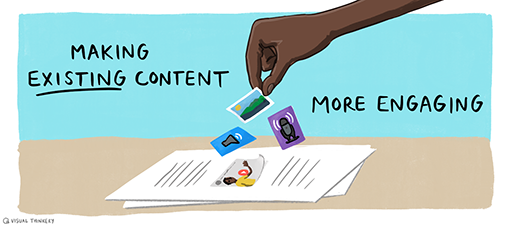Week 4 Selecting technologies
Introduction
This week provides an overview of the main tools available for creating digital content, what they offer, and how they can be used to support and facilitate online learning. It does not aim to be (and could never be) comprehensive, but it includes a selection of online resources that you may find useful for further exploration. It also includes some categorisations of these tools that you can use to understand the potential of some of the main types of tools for your own context. There are multiple blog posts, categorisations, discussions and sales pitches on the internet that relate to these tools. This week gives you a starting point from which to navigate these tools and use them to your advantage.
A note on privacy and personal information, which is particularly relevant if you are registering for and trying out different tools. If you are concerned by the privacy implications of using some of the tools covered in these materials, one approach is to use an alias when creating your account with them, and to create a separate email address (for example, using Gmail) for the purpose of registering for the service instead of using your institutional email address. However, this approach will not make your actions truly anonymous or private – the service provider or your own internet service provider (ISP) will be able to identify that it is your computer accessing the service. It is possible to take further steps such as browsing in private or using an anonymous surfing mode. Most browsers offer this feature. For example, in Google Chrome, Incognito [Tip: hold Ctrl and click a link to open it in a new tab. (Hide tip)] enables anonymous browsing; in Firefox, and Microsoft Edge, it is called private browsing. However, discussion of the pros and cons of such techniques is beyond the scope of this course.
Practitioner reflections
This week begins with a video from Sarah, who explains how she decides on the tools she uses to teach her nursing students. Before watching the video or reading the transcript, reflect on what you consider when you choose a tool, an application or a new technology to support students or other staff. As you watch the video or read the transcript, make a note of the decisions that Sarah mentions and whether these decisions would involve managers, educators, collaborators/support staff or a combination of these groups.
Transcript
[WRITTEN QUESTION] How did you learn to choose between tools?
Learning outcomes
By the end of this week, you should be able to:
- find, evaluate, manage, curate, organise and share digital content for learning, teaching and assessment
- produce digital materials in a variety of formats;
- design digital activities for different contexts;
- take into account issues such as accessibility, usability and openness;
- investigate and implement new digital approaches to learning, teaching and assessment;
- use digital tools to plan, design and review courses of study;
- use digital tools to plan and reflect on learning and support learners or other staff to do the same.

